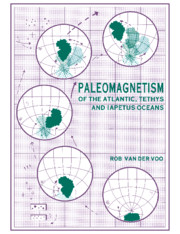Book contents
- Frontmatter
- Contents
- Preface and acknowledgements
- 1 Prologue
- 2 Paleopoles and paleomagnetic directions
- 3 Megaplates, microplates, blocks, terranes, accreted slivers, thrusts and olistostromes
- 4 Paleomagnetic information – what makes a paleopole valuable?
- 5 The major continents and Pangea
- 6 The opening of the Atlantic Ocean
- 7 The Tethys blocks
- 8 The terranes, blocks and adjacent continents of the Iapetus Ocean
- 9 Epilogue
- 10 Appendix
- References
- Index
2 - Paleopoles and paleomagnetic directions
Published online by Cambridge University Press: 24 November 2009
- Frontmatter
- Contents
- Preface and acknowledgements
- 1 Prologue
- 2 Paleopoles and paleomagnetic directions
- 3 Megaplates, microplates, blocks, terranes, accreted slivers, thrusts and olistostromes
- 4 Paleomagnetic information – what makes a paleopole valuable?
- 5 The major continents and Pangea
- 6 The opening of the Atlantic Ocean
- 7 The Tethys blocks
- 8 The terranes, blocks and adjacent continents of the Iapetus Ocean
- 9 Epilogue
- 10 Appendix
- References
- Index
Summary
The measurement of a rock sample magnetization is expressed by three values: the two angles of declination (D) and inclination (I) and the scalar magnetic intensity value (J). The latter is, of course, of limited value for tectonic purposes. The declination is an angle in the locally defined horizontal plane, measured clockwise from 0 to 360°, with reference to the geographic meridian (i.e., true, present north). In terms of the present-day geomagnetic field, it would be the angle between the direction in which a compass needle is pointing and the reference line of the meridian. Modern day declinations, except in very high latitudes, are typically less than 15°; because the magnetic poles are close to the geographic ones, the compass needle pointing towards the magnetic (north) pole, points also more or less in the direction of the geographic (north) pole.
The inclination is the angle, in the vertical plane, between the magnetic direction and the horizontal. Thus a horizontal magnetic direction has an inclination of 0°, and for a vertical direction I = 90°. Convention dictates positive I for downward and negative I for upward directions.
While the declination tells us the direction in which to seek the pole, the inclination provides the distance between the site and the pole. Together, then, D and I define a magnetic direction and its corresponding pole. However, some assumptions are made along the way, so it may not be as simple as that.
- Type
- Chapter
- Information
- Publisher: Cambridge University PressPrint publication year: 1993



